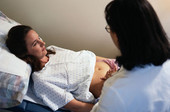
FRIDAY. Feb. 3 (HealthDay News) — The babies of women who develop an epidural-related fever while in labor are at greater risk of having problems right at birth, including poor muscle tone, breathing difficulties, low Apgar scores and seizures, a new study suggests.
The Apgar score is a test used to measure a child’s skin color, pulse and overall vigor in the moments after birth.
Prior research has found an association between epidurals — or anesthesia delivered into the epidural space around the spinal cord — and fevers in some moms during labor.
This study, which involved more than 3,200 women delivering a full-term baby at Brigham and Women’s Hospital in Boston in 2000, found a similar association.
Just over 19 percent of those who had an epidural developed a temperature of greater than 100.4 degrees F compared with just 2.4 percent of women who went without the painkiller.
The higher a woman’s temperature, the more likely the baby was to experience problems.
For example, about 11 percent of babies whose mothers that a normal or only slightly elevated temperature at birth had low muscle tone lasting less than 15 minutes at birth, compared with about 25 percent of babies with moms who had a fever above 101 degrees.
About 4.4 percent of babies with moms whose temperatures were normal needed resuscitation measures at delivery, ranging from breathing assistance to chest compressions, compared with more than 12 percent of babies whose mothers had a fever of over 101 degrees.
Only eight babies in the study experienced seizures, but babies whose moms had a fever of 101 degrees or greater were more likely to be among them, according to the study.
Researchers took into account other factors that could affect the baby’s health at birth, such as gestational diabetes in the mother or a known infection in the mother or the baby.
For women who didn’t develop a fever, researchers found no differences in outcomes for babies for women who had an epidural vs. those who didn’t.
“It’s clear that from our data that about 20 percent of the term infants born to mothers who received epidurals experienced one or more adverse outcomes after birth,” said study author Elizabeth Greenwell, a doctoral candidate at Harvard School of Public Health when she did the research.
The study is published in the February issue of Pediatrics.
More than 60 percent of the 4 million women who give birth each year in the United States get epidurals, according to background information in the study. In some hospitals, the number is much higher than that. In the group of women who delivered in Boston, for example, 87 percent had epidurals.
In this group of women receiving epidurals, 8.6 percent developed a fever of higher than 101 degrees; 10.7 percent had a temperature of 100.5 to 101 degrees; and 25.5 percent had a temperature of 99.6 degrees to 100.4 degrees.
Those who developed fevers tended to be older, and have larger babies and longer labors.
The reasons for the link between epidural and fever aren’t well understood, but it’s believed that inflammatory processes are involved, Greenwell said.
Most epidural-related fevers emerge after the woman has been numb for six hours or more, Greenwell noted, so one option for women who are worried about it might want to delay getting the epidural for as long as they can, she said.
Dr. Eva Pressman, a maternal-fetal medicine specialist at University of Rochester Medical Center, said “epidural fevers” indeed occur.
However, in this study, researchers didn’t do enough to rule out another cause for the fever, intrauterine infection. Those infections can come on quickly during labor and can be very serious for the baby, including causing brain damage, Pressman said. Known as chorioamnionitis, intrauterine infections are caused by bacteria from the vagina, that, as the cervix opens, inflames the fetal membranes.
“Chorioamnionitis has been strongly associated with adverse neonatal outcomes, especially cerebral palsy,” Pressman said.
To confirm that fevers were due to the epidural and not an infection, researchers would have had to examine the placenta after birth, she said.
What’s also not reported is if the women received IV antibiotics to treat an infection, or acetaminophen to treat fever, and if that would have improved how the child did, Pressman said.
“You can’t tell if the adverse outcome was related to the epidural or an underlying infection that was inadequately treated,” she said. “But it does reinforce that fever in labor is marker for some sort of inflammatory processes, but whether that inflammatory process is related to an epidural or an underlying infectious process, this study doesn’t tell us.”
More information
Nemours has more on epidurals.

